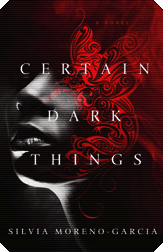Certain Dark Things
by Silvia Moreno-Garcia
Reviewed by Galen Strickland
Posted August 28, 2016 (with later edits)
Buy from Bookshop or Amazon. A purchase through our links may earn us a commission.
Please note: the original hardcover went out of print and never got a paperback release from the first publisher. It has been re-released in paperback by Tor Nightfire. The links above are for the new edition, and so is the cover image to the right. I like it a lot, but still love the original cover (see below). I don't have the new edition yet, but will likely buy it eventually, since the author said there have been some content edits. Comments below are my original thoughts from 2016.
I received a free e-book of this title from NetGalley in exchange for an honest review. I've already read it twice, but will still likely buy it [I did]. I'm not a frequent reader of horror, even less so than for fantasy, but I loved Silvia's first novel, Signal to Noise, so naturally I was interested in her next effort. Certain Dark Things is set in the present day, but in an alternate world in which vampires were outed sometime in the late 1960s. Many countries deported them, some tolerated them in segregated communities, while corrupt officials in Mexico turned a blind eye to their immigration. Later, Mexico City seceded from the rest of the country and established itself as an independent city-state, declaring itself to be a vampire-free zone. In the rest of Mexico, various vampire clans had taken over the drug trade. There had been at least ten specific sub-species of vampire identified, several unique to Europe, others from Asia and Africa. There's a great glossary at the end of the book, detailing the histories of the various species. The only common factor of their natures was a dependence on humans as a food source. Most are blood-suckers, although there are different methods of extraction, and at least one type, Revenants, can absorb the life essence of both human and other vampires without spilling blood. Some species have shape-shifting capabilities, and almost all have the power of rapid healing. Bram Stoker's Dracula and other stories and films were still a part of this alternate world, but until the '60s everyone thought of them as fantastical myths. Now, some details from the stories are used to describe certain aspects of the culture. For instance, a human servant of a vampire is referred to as a Renfield, a vampire hunter a Van Helsing.
The most interesting of the species, and the one most central to the plot, is the Tlāhuihpochtli, native to Mexico. They had served as priests and priestesses in Aztec temples, although they pre-dated the rise of that empire, and it is unclear whether they influenced Aztec blood rituals or whether the Aztecs embraced them as gods because they shared their affinity for blood sacrifice. Atl Iztac flees northern Mexico after most of her family are killed by a rival group of Necros, first to Guadalajara, where she escapes them again, then to Mexico City. There is an ancient vampire, the Revenant Bernardino, believed to still reside in the city, who had known her mother during the Mexican Revolution. She hopes he will help her obtain false documents that will allow her to leave the country for South America. Little does she know that her path will cross that of Domingo, a boy who lives in an abandoned subway tunnel, and who makes his living scrounging trash and recyclables from landfills and dumpsters. Her species needs to feed off young humans, he has long been fascinated with vampire stories from comics and films. Their association could prove fatal for both of them. Other characters include policewoman Ana Aguirre, whose reputation as a knowledgeable vampire killer from Zacatecas preceeded her move to Mexico City, and Nick Godoy, the reckless Necros on Atl's trail, along with his Renfield, Rodrigo.
 |
No matter what you may think of vampires, you're probably like me and only familiar with the standard tropes of Stoker or the films adapted from his novel. Or maybe the modern, romantic twists like Buffy or Twilight. Forget those. This is a reinvention, quite possibly the beginning of the new standard, with believable and consistent world-building. The story is dark and gritty of course, very suspenseful, with Aguirre's investigation reminiscent of a Hammett or Chandler mystery mixed with the Stoker horror, with a bit of Lansdale-like humor thrown in. It's also appropriately violent and bloody, extremely so at the climax. However, its strengths are the characters and the descriptive exposition, with Mexico City culture and geography vividly portrayed as well as any of the characters. I'd love to see this adapted to film. Atl, although descended from Aztec warriors, is herself vulnerable and overly cautious. She hates that she has become dependent on Domingo, while he is surprisingly strong and fearless against formidable odds, and completely loyal to her. I cared about Atl and Domingo, both separately and together, but also about Ana, all the while knowing their fates were destined to crash together. Not all of them survive to the end, but I won't say more about that. No matter whom you identify with, there will be multiple times you will fear for their safety. As with her previous novel, this one is highly recommended. I don't know what Silvia will write next, but whatever it is, I'm already interested.
Related Links:
Silvia's Official Website
My other reviews of her books
We would appreciate your support for this site with your purchases from Amazon, Bookshop, and ReAnimusPress.